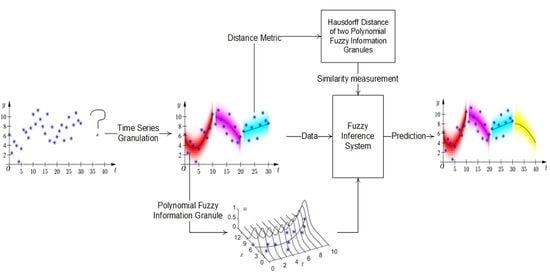Polynomial Fuzzy Information Granule-Based Time Series Prediction
Abstract
1. Introduction
2. Fuzzy Information Granules and Their Distance
2.1. Fuzzy Numbers and Their Distance Measurement
- (a)
- is normal: there exists a number such that ;
- (b)
- is convex: ,;
- (c)
- is upper semicontinuous: , , if , then .
- (d)
- is compactly supported: the closure of the set is compact.
2.2. Fuzzy Information Granules and Their Distance
2.2.1. Interval Fuzzy Information Granules and Their Distance
2.2.2. Triangular Fuzzy Information Granules and Their Distance
2.2.3. Gaussian Fuzzy Information Granules and Their Distance
3. Polynomial Fuzzy Information Granules and Their Distance Metric
3.1. Polynomial Fuzzy Information Granules
- The length of the time series , i.e., the size of time window, ;
- A time-variant -order center (regression) curve line that reflects the changing of the time series;
- The parameters reflecting the deviation degree of the temporal data from the center line.
3.2. Distance Metric of Polynomial Fuzzy Information Granules
4. Granular Time Series Prediction Method Based on Fuzzy Inference
4.1. Granule Based Fuzzy Inference
4.2. Flow Chart of the Proposed Algorithm
| Algorithm 1: Time series prediction algorithm based on FIS and GPFIGs. |
| Input: A numerical time series of length ; the granularity (length of time window) and the polynomial order of PFIG. Number of antecedents of the fuzzy rules in the FIS. Output: . |
|
5. Experimental Research
5.1. Data Description and Experimental Scheme
- Root mean-square error:
- Symmetric mean absolute percentage error:
- AR(): Numerical -order auto regressive model (auto regressive, AR):
- NAR(): the -order NAR is a -input 1-output feedforward network, whose input is a vector consisting of data before time in the given training sequence, and output is the datum in time , . The NAR uses a sigmoid transfer function in the hidden layer and a linear transfer function in the output layer. The number of hidden neurons as well as the number of hidden layers is set to 10.
- SVR(): numerical -order support vector machine regress model (support vector regress, SVR) [39]:
- LSTM: a sequence-to-sequence regression LSTM network, where the responses are the training sequences with values shifted by one time step. The LSTM updates the cell and hidden states using the hyperbolic tangent function and uses the sigmoid function as the gate activation function. The number of hidden units is set to 128.
- IFIG-FIS: the FIS prediction method based on the IFIG. Equations (4) and (5) are used to granulate the time series, and the FIS with -input is used for the prediction.
- TFIG-FIS: the FIS prediction method based on the TFIG. Equations (7) and (8) are used to granulate the time series, and the FIS with -input is used for the prediction.
- GFIG-FIS: the FIS prediction method based on the GFIG. The average and standard deviation of the corresponding window data are used as the parameters in constructing the GFIG, and the FIS with -input is used for the prediction.
- LIFG-FIS: the FIS prediction method based on the LFIG. The linear regression line and the estimate of the error variance are used as the parameters in constructing the LIFG, and the FIS with -input is used for the prediction.
5.2. The Experimental Results
5.2.1. Daily Minimum Temperature Dataset
5.2.2. Power Consumption Time Series
5.2.3. American Heart Association Electrocardiogram Time Series
6. Summary
Author Contributions
Funding
Data Availability Statement
Acknowledgments
Conflicts of Interest
References
- Zhang, H.; Nguyen, H.; Bui, X.-N.; Biswajeet, P.; Mai, N.-L.; Vu, D.A. Proposing two novel hybrid intelligence models for forecasting copper price based on extreme learning machine and meta-heuristic algorithms. Resour. Policy 2021, 73, 102195. [Google Scholar] [CrossRef]
- Wang, H.; Luo, C.; Wang, X. Synchronization and identification of nonlinear systems by using a novel self-evolving interval type-2 fuzzy LSTM-neural network. Eng. Appl. Artif. Intell. 2019, 81, 79–93. [Google Scholar] [CrossRef]
- Jiang, P.; Yang, H.; Li, H.; Wang, Y. A developed hybrid forecasting system for energy consumption structure forecasting based on fuzzy time series and information granularity. Energy 2021, 219, 119599. [Google Scholar] [CrossRef]
- Box, G.; Jenkins, G.; Reinsel, G. Forecasting and Control, 4th ed.; Time Series Analysis; John Wiley & Sons: New York, NY, USA, 2008. [Google Scholar]
- Moon, J.; Hossain, M.B.; Chon, K. AR and ARMA model order selection for time-series modeling with ImageNet classification. Signal Process. 2021, 183, 108026. [Google Scholar] [CrossRef]
- Xian, H.; Che, J. Unified whale optimization algorithm based multi-kernel SVR ensemble learning for wind speed forecasting. Appl. Soft Comput. 2022, 130, 109690. [Google Scholar] [CrossRef]
- Yoon, H.; Hyun, Y.; Ha, K.; Lee, K.-K.; Kim, G.-B. A method to improve the stability and accuracy of ANN- and SVM-based time series models for long-term groundwater level predictions. Comput. Geosci. 2016, 90, 144–155. [Google Scholar] [CrossRef]
- Sunayana; Kumar, S.; Kumar, R. Forecasting of municipal solid waste generation using non-linear autoregressive (NAR) neural models. Waste Manag. 2021, 121, 206–214. [Google Scholar] [CrossRef] [PubMed]
- Bandara, K.; Bergmeir, C.; Smyl, S. Forecasting across time series databases using recurrent neural networks on groups of similar series: A clustering approach. Expert Syst. Appl. 2020, 140, 112896. [Google Scholar] [CrossRef]
- Arsov, M.; Zdravevski, E.; Lameski, P.; Corizzo, R.; Koteli, N.; Gramatikov, S.; Mitreski, K.; Trajkovik, V. Multi-Horizon Air Pollution Forecasting with Deep Neural Networks. Sensors 2021, 21, 1235. [Google Scholar] [CrossRef]
- Livieris, I.E.; Pintelas, E.; Pintelas, P. A CNN–LSTM model for gold price time-series forecasting. Neural Comput. Appl. 2020, 32, 17351–17360. [Google Scholar] [CrossRef]
- Jin, X.; Yu, X.; Wang, X.; Bai, Y.; Su, T.; Kong, J. Prediction for Time Series with CNN and LSTM. In Proceedings of the 11th International Conference on Modelling, Identification and Control (ICMIC2019), Tianjin, China, 4 December 2019; Wang, R., Chen, Z., Zhang, W., Zhu, Q., Eds.; Springer: Singapore, 2020; p. 59. [Google Scholar]
- Jilani, T.A.; Burney, S.M.A. M-factor high order fuzzy time series forecasting for road accident data: Analysis and design of intelligent systems using soft computing techniques. Adv. Soft Comput. 2007, 41, 246–254. [Google Scholar]
- Wang, L.; Xue, T.; Wang, H.; Liu, Z. Research on stock index forecasting based on recurrent neural network. J. Zhejiang Univ. Technol. 2019, 47, 186–191. [Google Scholar]
- Wang, X.; Wu, J.; Liu, C.; Yang, H.; Niu, W. Exploring LSTM based recurrent neural network for failure time series prediction. J. Beijing Univ. Aeronaut. Astronaut. 2018, 44, 772–784. [Google Scholar]
- Tang, Y.; Yu, F.; Pedrycz, W.; Yang, X.; Wang, J.; Liu, S. Building trend fuzzy granulation based LSTM recurrent neural network for long-term time series forecasting. IEEE Trans. Fuzzy Syst. 2022, 30, 1599–1613. [Google Scholar] [CrossRef]
- Cheng, R.; Yu, J.; Zhang, M.; Feng, C.; Zhang, W. Short-term hybrid forecasting model of ice storage air-conditioning based on improved SVR. J. Build. Eng. 2022, 50, 104194. [Google Scholar] [CrossRef]
- Keogh, E.; Kasetty, S. On the need for time series data mining benchmarks: A survey and empirical demonstration. Data Min. Knowl. Discov. 2002, 7, 102–111. [Google Scholar]
- Zadeh, L. Advances in Fuzzy Set Theory and Applications; World Scientific Publishing: Amsterdam, The Netherlands, 1979; pp. 3–18. [Google Scholar]
- Pedrycz, W.; Vukovich, G. Abstraction and specialization of information granules. IEEE Trans. Syst. Man Cybern. Part B 2001, 31, 106–111. [Google Scholar] [CrossRef]
- Guo, J.; Lu, W.; Yang, J.; Liu, X. A rule-based granular model development for interval-valued time series. Int. J. Approx. Reason. 2021, 136, 201–222. [Google Scholar] [CrossRef]
- Ruan, J.; Wang, X.; Shi, Y. Developing fast predictors for large-scale time series using fuzzy granular support vector machines. Appl. Soft Comput. 2013, 13, 3981–4000. [Google Scholar] [CrossRef]
- Zhou, Y.; Ren, H.; Li, Z.; Pedrycz, W. Anomaly detection based on a granular Markov model. Expert Syst. Appl. 2022, 187, 115744. [Google Scholar] [CrossRef]
- He, L.; Chen, Y.; Zhong, C.; Wu, K. Granular Elastic Network Regression with Stochastic Gradient Descent. Mathematics 2022, 10, 2628. [Google Scholar] [CrossRef]
- Hu, M.; Wang, C.; Yang, J.; Wu, Y.; Fan, J.; Jing, B. Rain Rendering and Construction of Rain Vehicle Color-24 Dataset. Mathematics 2022, 10, 3210. [Google Scholar] [CrossRef]
- Yu, F.; Pedrycz, W. The design of fuzzy information granules: Tradeoffs between specificity and experimental evidence. Appl. Soft Comput. 2009, 9, 264–273. [Google Scholar] [CrossRef]
- Pedrycz, W.; Wang, X. Designing fuzzy sets with the use of the parametric principle of justifiable granularity. IEEE Trans. Fuzzy Syst. 2016, 24, 489–496. [Google Scholar] [CrossRef]
- Dong, K. Time Series Information Granulation and Clustering Analysis Based on Granulation; Beijing Normal University: Beijing, China, 2005. [Google Scholar]
- Yang, X.; Yu, F.; Pedrycz, W. Long-term forecasting of time series based on linear fuzzy information granules and fuzzy inference system. Int. J. Approx. Reason. 2017, 81, 1–27. [Google Scholar] [CrossRef]
- Luo, C.; Song, X.; Zheng, Y. A novel forecasting model for the long-term fluctuation of time series based on polar fuzzy information granules. Inf. Sci. 2020, 512, 760–779. [Google Scholar] [CrossRef]
- Luo, C.; Wang, H. Fuzzy forecasting for long-term time series based on time-variant fuzzy information granules. Appl. Soft Comput. 2020, 88, 106046. [Google Scholar] [CrossRef]
- Tang, Y.; Yu, F. Fuzzy information granulation: Review of theory and applications. J. Beijing Norm. Univ. 2022, 58, 349–361. [Google Scholar]
- Zadeh, L.A. Fuzzy sets. Inf. Control 1965, 8, 338–353. [Google Scholar] [CrossRef]
- Shen, Y. Calculus for linearly correlated fuzzy number-valued functions. Fuzzy Sets Syst. 2022, 429, 101–135. [Google Scholar] [CrossRef]
- Rote, G. Computing the minimum Hausdorff distance between two point sets on a line under translation. Inf. Process. Lett. 1991, 38, 123–127. [Google Scholar] [CrossRef]
- Dubois, D.; Prade, H. Fundamentals of Fuzzy Sets; Springer: New York, NY, USA, 2000; p. 90. [Google Scholar]
- Yu, F.; Dong, K.; Chen, F.; Jiang, Y.; Zeng, W. Clustering Time Series with Granular Dynamic Time Warping Method. In Proceedings of the Clustering Time Series with Granular Dynamic Time Warping Method, Fremont, CA, USA, 2–4 November 2007; p. 393. [Google Scholar]
- Luo, C.; Yu, F.; Zeng, W. Introduction to Fuzzy Sets; Beijing Normal University Press: Beijing, China, 2019. [Google Scholar]
- Fan, R.; Chang, K.; Hsieh, C.; Wang, X.R.; Lin, C.J. LIBLINEAR: A library for large linear classification. J. Mach. Learn. Res. 2008, 9, 1871–1874. [Google Scholar]


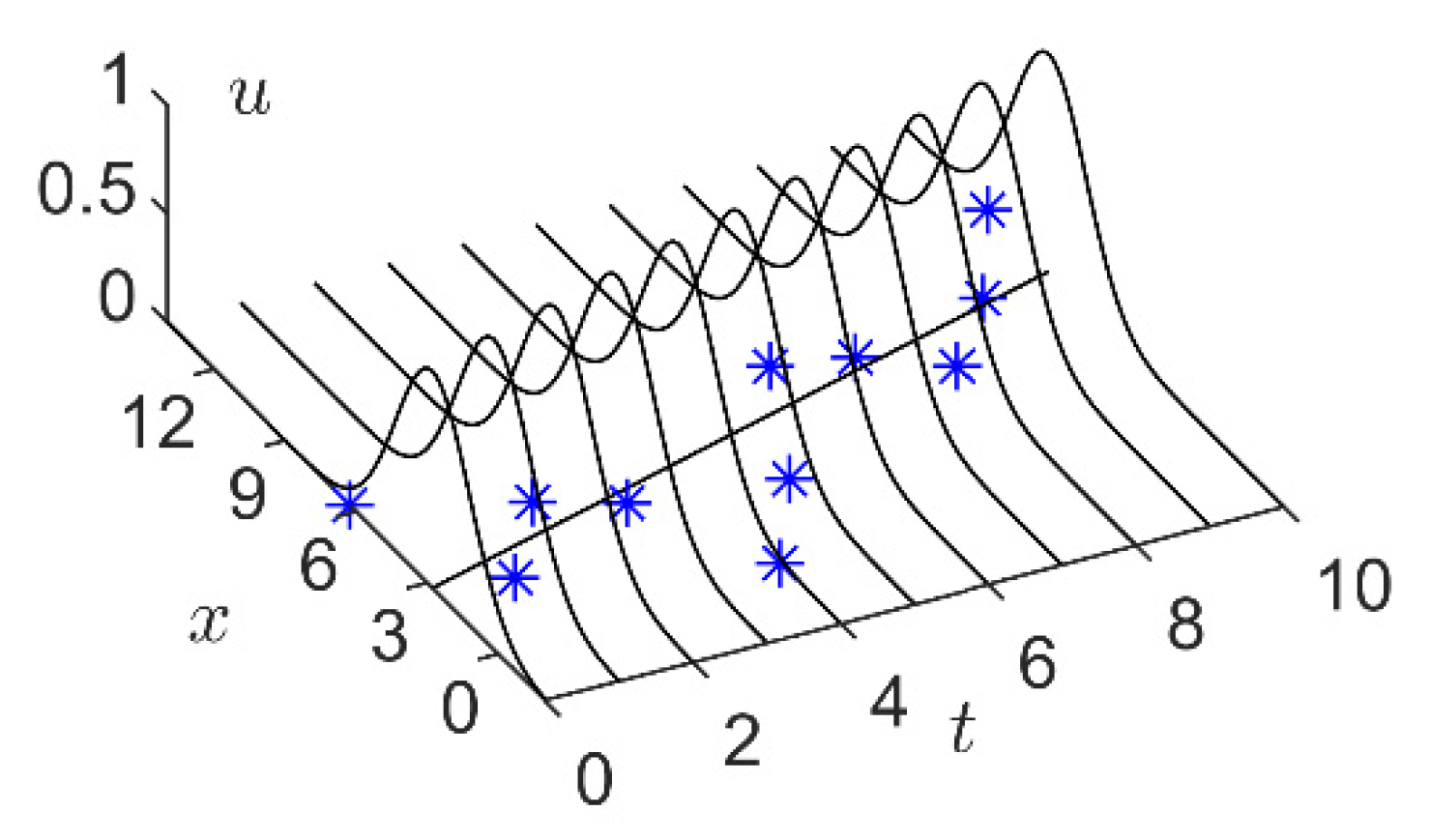

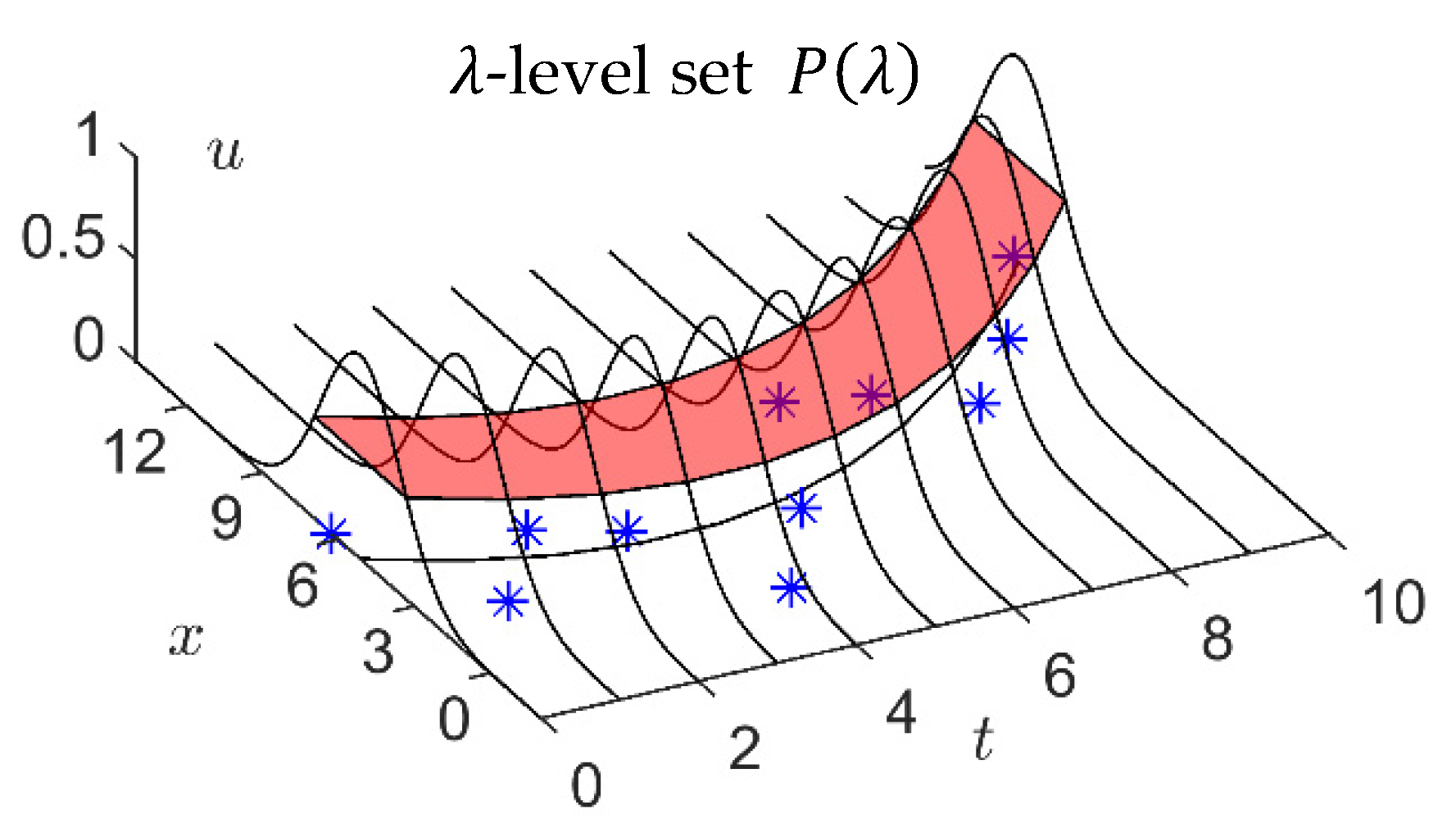

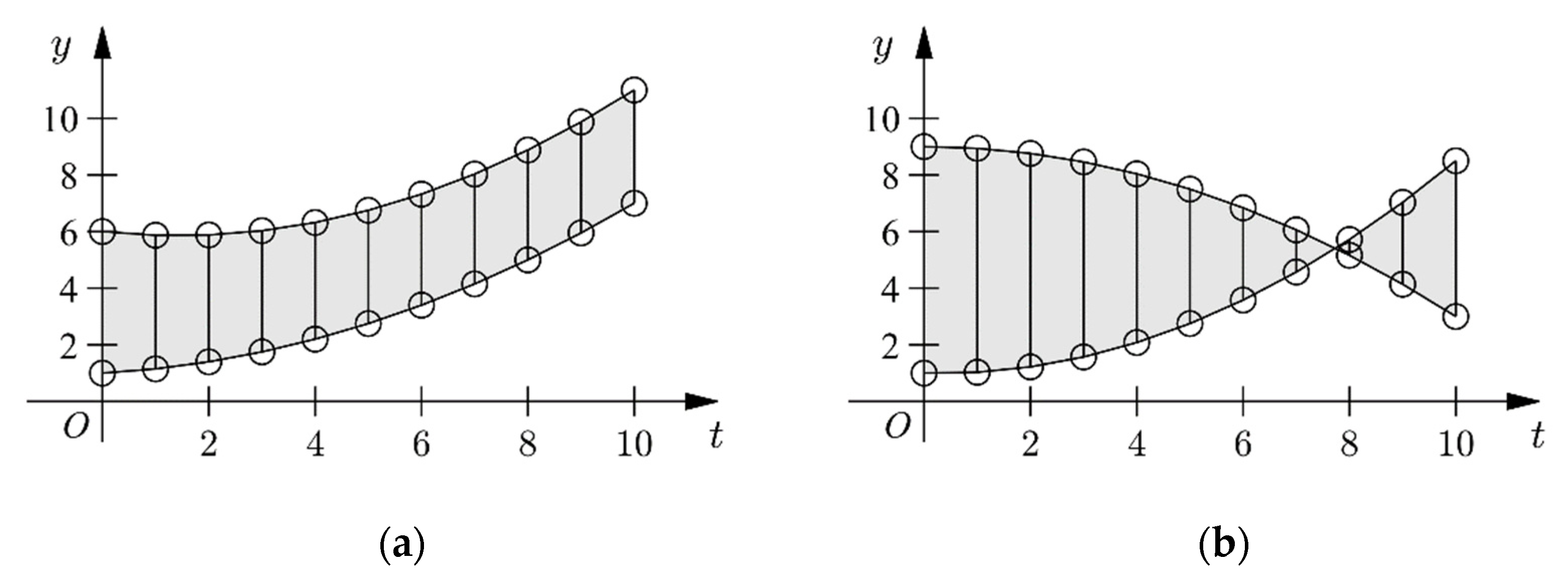


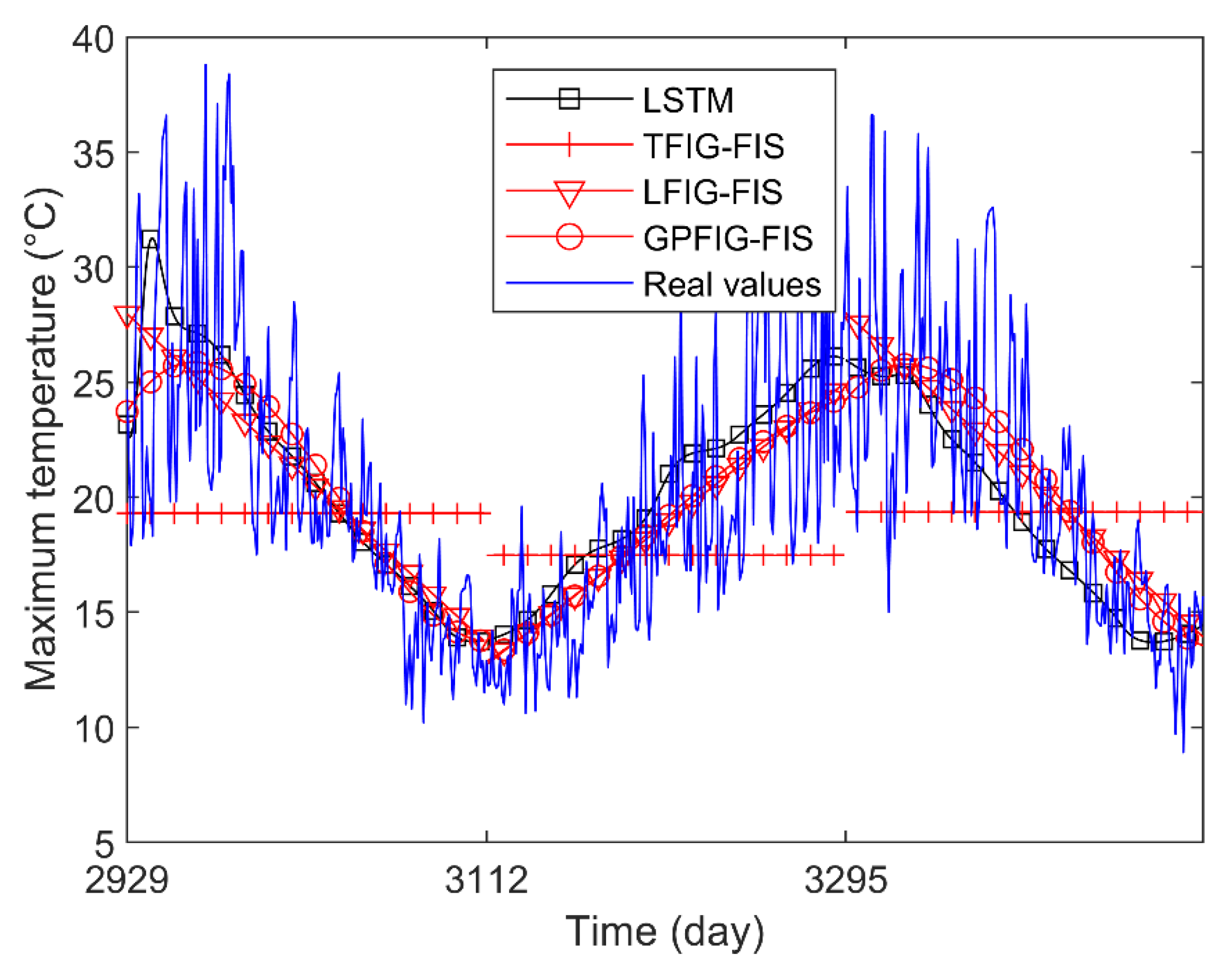
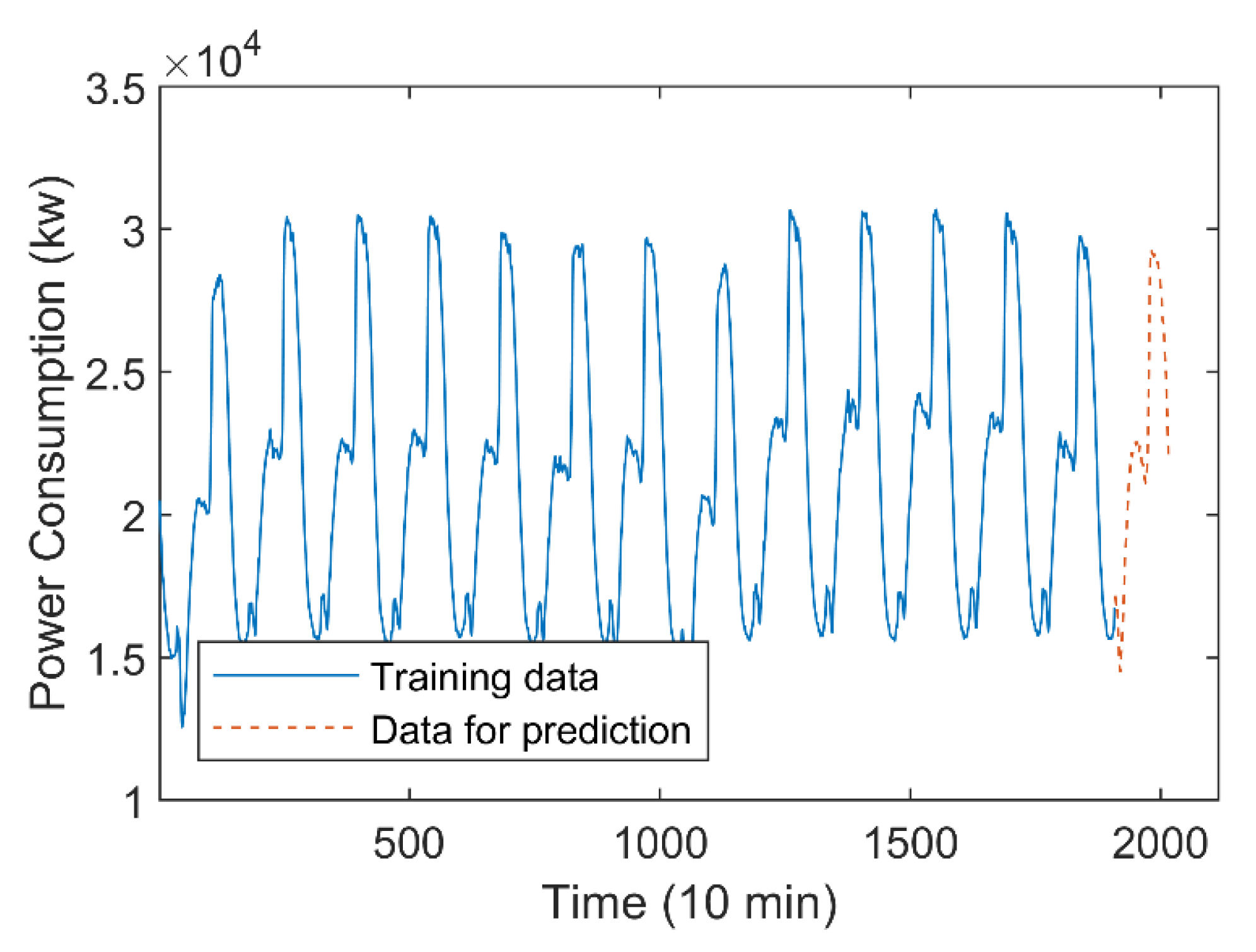

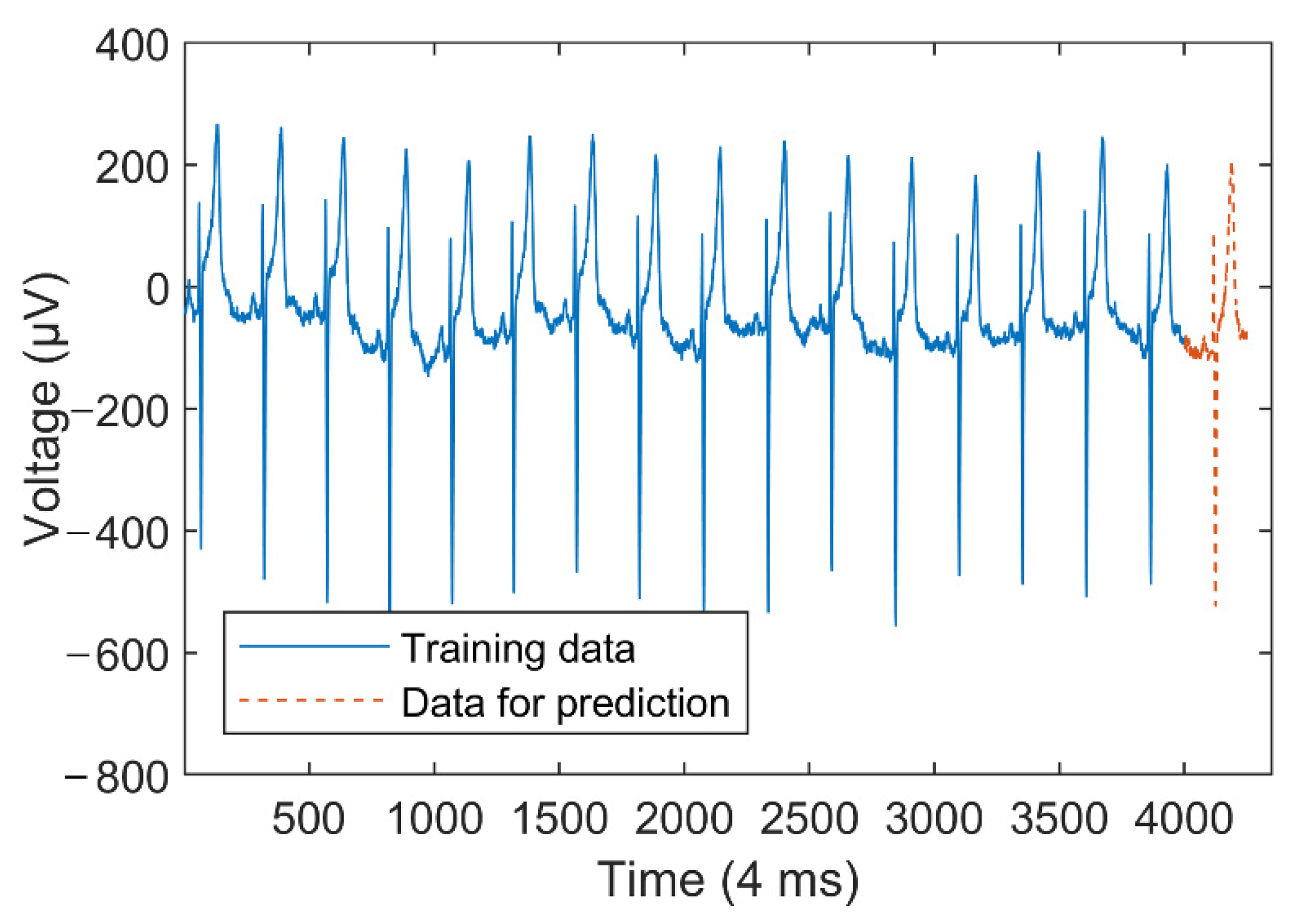
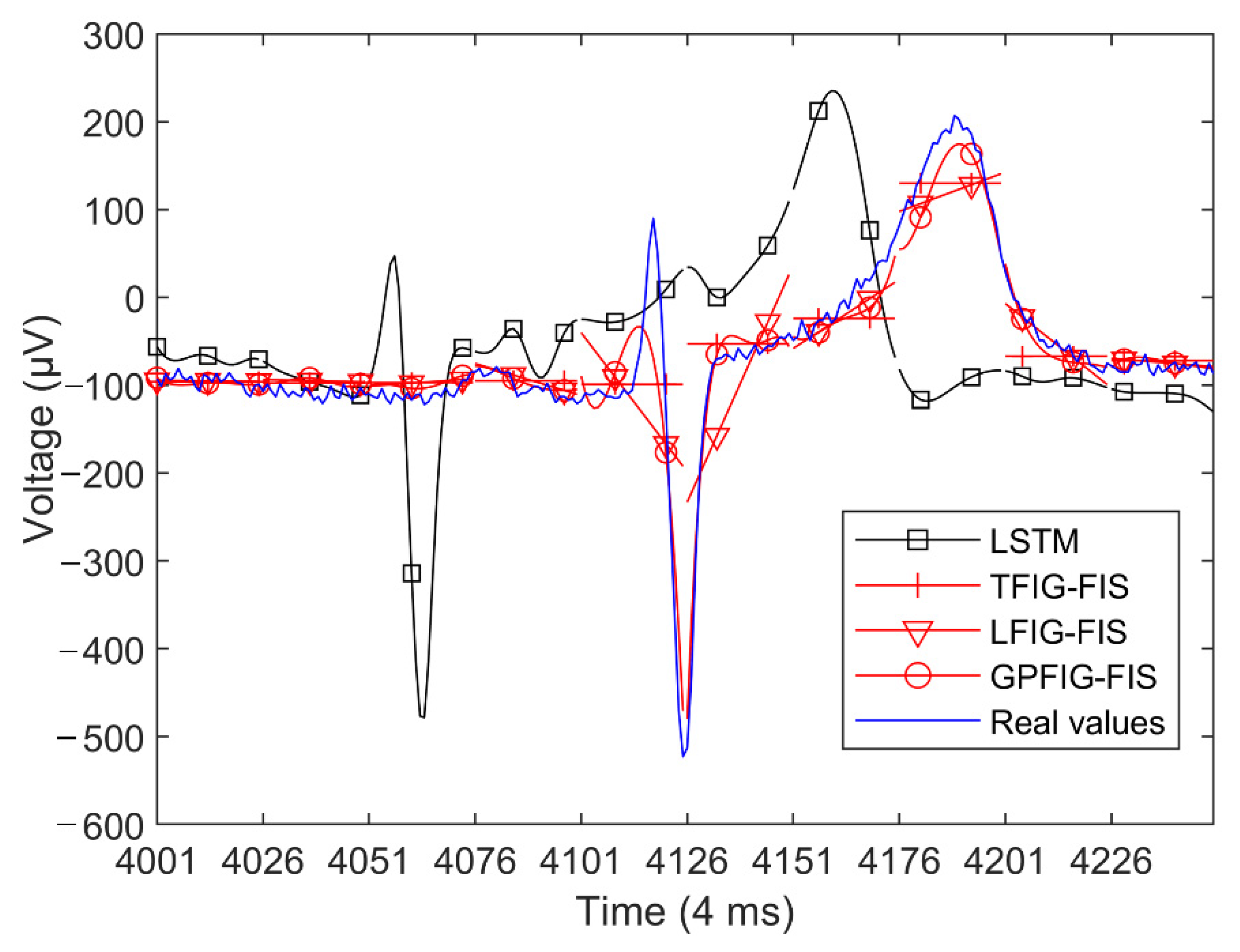
| Index | Time (Day) | AR | NAR | SVR | LSTM | IFIG-FIS | TFIG-FIS | GFIG-FIS | LFIG-FIS | GPFIG-FIS |
|---|---|---|---|---|---|---|---|---|---|---|
| RMSE | 2929–3112 | 9.83 | 6.79 | 6.49 | 4.30 | 8.76 | 6.67 | 6.45 | 4.44 | 4.19 |
| 2929–3295 | 14.76 | 7.01 | 6.54 | 4.25 | 7.57 | 6.39 | 6.18 | 4.27 | 4.14 | |
| 2929–3478 | 17.23 | 6.83 | 6.4 | 4.25 | 7.86 | 6.31 | 6.11 | 4.19 | 4.04 | |
| SMAPE | 2929–3112 | 42.02 | 27.58 | 24.74 | 14.32 | 28.14 | 21.67 | 22.38 | 14.66 | 14.11 |
| 2929–3295 | 62.34 | 30.63 | 27.23 | 15.51 | 24.48 | 21.27 | 21.97 | 14.71 | 14.48 | |
| 2929–3478 | 74.18 | 29.9 | 26.73 | 14.87 | 25.85 | 21.74 | 22.47 | 14.66 | 14.28 |
| Index | Time (10 min) | AR | NAR | SVR | LSTM | IFIG-FIS | TFIG-FIS | GFIG-FIS | LFIG-FIS | GPFIG-FIS |
|---|---|---|---|---|---|---|---|---|---|---|
| RMSE | 1909–1926 | 3479 | 3128 | 5556 | 2934 | 1630 | 1155 | 1033 | 1087 | 692 |
| 1927–1944 | 2800 | 2749 | 4130 | 2909 | 1647 | 1394 | 1306 | 854 | 565 | |
| 1945–1962 | 3030 | 3896 | 3415 | 3522 | 1394 | 1146 | 1077 | 718 | 482 | |
| 1963–1980 | 3803 | 4765 | 3347 | 3343 | 1790 | 1701 | 1676 | 1141 | 691 | |
| 1981–1998 | 6020 | 6815 | 4504 | 3755 | 1687 | 1603 | 1547 | 1101 | 744 | |
| 1999–2016 | 6500 | 7273 | 4526 | 3828 | 1823 | 1657 | 1617 | 1065 | 754 | |
| SMAPE | 1909–1926 | 19.11 | 16.68 | 32.89 | 16.87 | 8.27 | 5.55 | 5.12 | 5.17 | 3.36 |
| 1927–1944 | 13.77 | 13.35 | 20.14 | 14.79 | 7.64 | 6.22 | 5.99 | 3.68 | 2.62 | |
| 1945–1962 | 14.92 | 18.04 | 14.94 | 17.29 | 6.12 | 4.42 | 4.33 | 2.88 | 2.07 | |
| 1963–1980 | 16.89 | 21.15 | 13.29 | 15.36 | 7.08 | 5.48 | 6.38 | 4.21 | 2.7 | |
| 1981–1998 | 22.99 | 27.07 | 17.05 | 16.61 | 6.66 | 5.33 | 5.81 | 4.16 | 2.95 | |
| 1999–2016 | 25.47 | 29.38 | 17.38 | 16.65 | 6.97 | 5.68 | 6.11 | 4.08 | 3.02 |
| Index | Time (4 ms) | AR | NAR | SVR | LSTM | IFIG-FIS | TFIG-FIS | GFIG-FIS | LFIG-FIS | GPFIG-FIS |
|---|---|---|---|---|---|---|---|---|---|---|
| RMSE | 4001–4025 | 87.91 | 22.74 | 41.06 | 26.83 | 7.33 | 7.43 | 7.7 | 7.2 | 7.96 |
| 4026–4050 | 99.24 | 40.4 | 48.48 | 22.58 | 8.61 | 10.67 | 13.03 | 12.01 | 11.84 | |
| 4051–4075 | 102.95 | 52.92 | 51 | 94.60 | 12.23 | 12.34 | 13.82 | 12.93 | 12.1 | |
| 4076–4100 | 102.58 | 67.47 | 50.23 | 85.65 | 12.68 | 12.85 | 14.2 | 12.27 | 11.31 | |
| 4101–4125 | 124.51 | 129.95 | 83.39 | 114.43 | 70.03 | 64.81 | 64.07 | 59.72 | 30.74 | |
| 4126–4150 | 131.99 | 164.89 | 93.48 | 130.28 | 107.32 | 80.48 | 76.25 | 65.06 | 29.18 | |
| 4151–4175 | 122.86 | 163.78 | 89.79 | 139.07 | 100.47 | 76.09 | 72.11 | 60.88 | 28.41 | |
| 4176–4200 | 127.1 | 154.01 | 111.27 | 157.61 | 95.37 | 73.1 | 69.92 | 60.01 | 28.8 | |
| 4201–4225 | 121.25 | 160.38 | 105.42 | 149.67 | 93.44 | 69.98 | 66.71 | 56.75 | 27.4 | |
| 4226–4250 | 117.79 | 169.45 | 100.35 | 142.36 | 88.9 | 66.46 | 63.34 | 53.9 | 26.14 | |
| SMAPE | 4001–4025 | 95.44 | 22.32 | 45.72 | 28.70 | 6.48 | 6.75 | 6.36 | 6.31 | 7.43 |
| 4026–4050 | 106.77 | 39.06 | 52.28 | 22.25 | 7.59 | 9.55 | 11.5 | 10.69 | 10.63 | |
| 4051–4075 | 111.88 | 52.56 | 55.11 | 59.09 | 10.77 | 11.42 | 12.75 | 11.87 | 11.2 | |
| 4076–4100 | 113.48 | 67.23 | 54.62 | 56.81 | 11.84 | 12.38 | 13.52 | 11.25 | 10.38 | |
| 4101–4125 | 114.54 | 91.74 | 60.64 | 66.26 | 25.84 | 23.55 | 24.93 | 27.62 | 19.71 | |
| 4126–4150 | 113.47 | 127.12 | 56.93 | 81.95 | 70.16 | 26.25 | 32.58 | 33.95 | 19.31 | |
| 4151–4175 | 106.49 | 164.82 | 67.18 | 150.81 | 71.01 | 31.95 | 37.2 | 35.64 | 23.8 | |
| 4176–4200 | 109.68 | 149.17 | 81.82 | 160.37 | 67.17 | 32.85 | 37.63 | 36.3 | 24.15 | |
| 4201–4225 | 107.33 | 174.87 | 79.45 | 152.83 | 73.07 | 37.05 | 40.11 | 35.21 | 23.45 | |
| 4226–4250 | 107.68 | 190.28 | 74.94 | 141.83 | 68.52 | 34.43 | 36.93 | 32.6 | 22.05 |
Publisher’s Note: MDPI stays neutral with regard to jurisdictional claims in published maps and institutional affiliations. |
© 2022 by the authors. Licensee MDPI, Basel, Switzerland. This article is an open access article distributed under the terms and conditions of the Creative Commons Attribution (CC BY) license (https://creativecommons.org/licenses/by/4.0/).
Share and Cite
Yang, X.; Zhang, S.; Zhang, X.; Yu, F. Polynomial Fuzzy Information Granule-Based Time Series Prediction. Mathematics 2022, 10, 4495. https://doi.org/10.3390/math10234495
Yang X, Zhang S, Zhang X, Yu F. Polynomial Fuzzy Information Granule-Based Time Series Prediction. Mathematics. 2022; 10(23):4495. https://doi.org/10.3390/math10234495
Chicago/Turabian StyleYang, Xiyang, Shiqing Zhang, Xinjun Zhang, and Fusheng Yu. 2022. "Polynomial Fuzzy Information Granule-Based Time Series Prediction" Mathematics 10, no. 23: 4495. https://doi.org/10.3390/math10234495
APA StyleYang, X., Zhang, S., Zhang, X., & Yu, F. (2022). Polynomial Fuzzy Information Granule-Based Time Series Prediction. Mathematics, 10(23), 4495. https://doi.org/10.3390/math10234495





